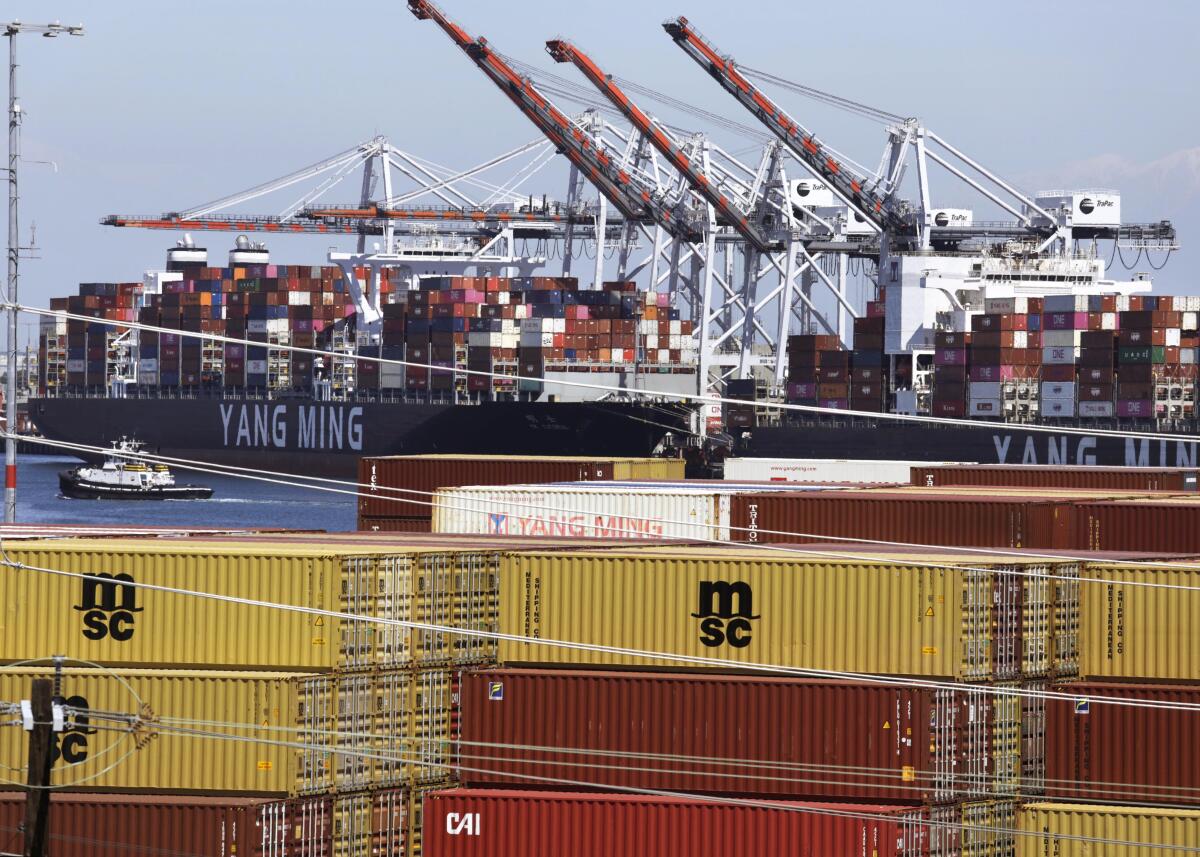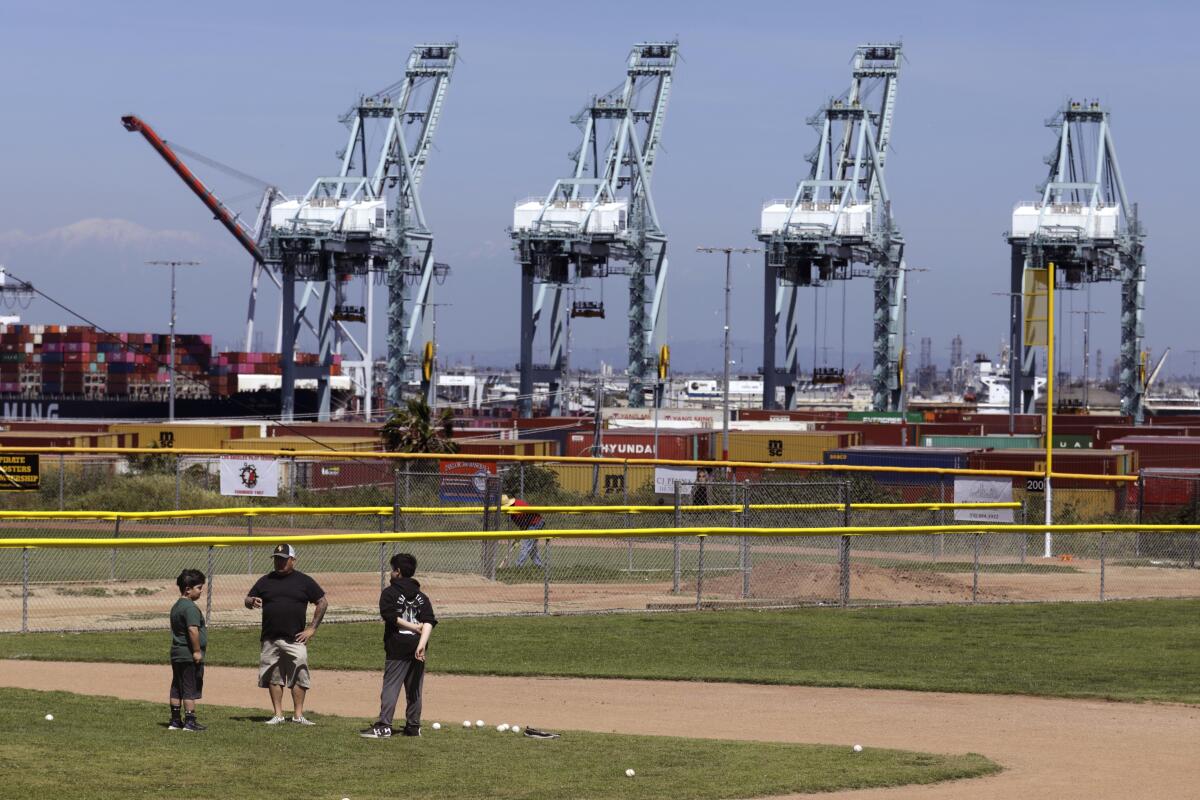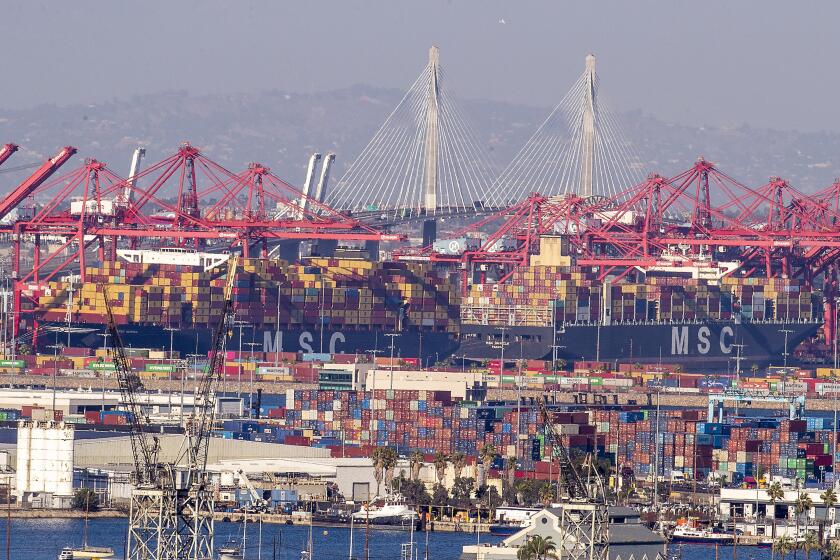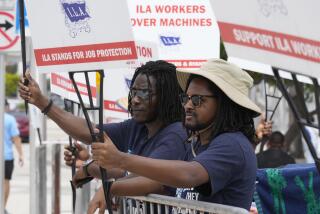Southern California ports reopen. Shutdown highlights high-stakes contract talks

Southern California dockworkers returned to the job Friday night, ending an approximately 24-hour shutdown at the Los Angeles and Long Beach ports â a crucial entry point for imports arriving from Asia.
The temporary closure has exacerbated fears about a logistics infrastructure that has never fully recalibrated since the COVID-19 pandemic delays and has shone a stark, national spotlight on the high-stakes labor negotiations playing out at the ports.
The union that represents West Coast dockworkers and the industry group representing maritime shippers are several months into negotiating a new contract, which is focused, in part, on wages and the role of automation. The old contract, covering more than 22,000 workers at 29 ports, expired July 1.
The Pacific Maritime Assn., the industry group representing shippers at the negotiating table, on Friday night listed most terminals at the twin ports as working compared with previous dispatch summaries that indicated most terminals were idle Thursday night and most of Friday.
The shippers group said in a statement early Friday that the International Longshore and Warehouse Union had taken a âconcerted action to withhold labor.â
âA majority of the jobs for last nightâs shift went unfilled, including all jobs for cargo-handling equipment operators needed to load and unload cargo,â the statement read. âThe workers who did show up were released because there was not a full complement of ILWU members to operate the terminals.â
But ILWU Local 13 said in a statement Friday afternoon that its members âare still hard at work and remain committed to moving the nationâs cargo.â The worker shortfall occurred because several thousand members had attended a monthly meeting Thursday evening and were then observing the Good Friday holiday, as allowed under the contract.
Although both sides have remained largely quiet about the status of the contract negotiations â appearing to adhere to an agreement laid out in a joint statement in February not to discuss the collective bargaining process in the media â the latest development underscored their significance.
Retailers and manufacturers have shifted cargo away from the L.A. and Long Beach ports, threatening local jobs. The ports vow to bring that trade back, but it wonât be easy.
âThis is quite clearly a wake-up call to the portsâ operators,â said Harley Shaiken, a professor emeritus at UC Berkeley who specializes in labor issues. âThis process hasnât just been slow, itâs been inching along with very high stakes in the balance.â
Because their members can shut down ports all along the West Coast, Shaiken said, the longshore union has unequaled power.
âThis has already caught the nationâs attention,â he said, âand should add a sense of urgency to the negotiations.â

The L.A. and Long Beach ports together handle nearly 40% of U.S. imports from Asia, which arrive in giant metal containers aboard vessels that stretch to nearly the length of the Empire State Building. But goods movement has fallen sharply in recent months, allowing the combined ports of New York and New Jersey to intermittently grab No. 1 bragging rights away from Los Angeles.
The local downward trend is worrisome not just to officials at the twin ports but also for 175,000 Southern California workers â employed at the harbors themselves as well as in related businesses â moving freight valued at $469 billion a year, port data show. At stake are jobs all along the supply chain, including truckers, warehouse workers and people employed by logistics specialists.
The ILWU, the union representing dockworkers across the West Coast, is at the bargaining table with the PMA, the group representing shipping companies. The current contract expires on July 1.
âItâs important that things return to normal as quickly as possible,â said Jock OâConnell, an international trade economist, who noted that local ports have lost considerable business to their rivals on the East and Gulf coasts. U.S. retailers and manufacturers redirected cargo following a huge backlog in San Pedro Bay that began in 2020, taking advantage of significant investments by competing ports looking to grab shipping business away from Southern California.
âItâs likely that some of that business will never come back,â said OâConnell, who works for Beacon Economics. The current stoppage, he added, will create a ripple effect, affecting a myriad of jobs and industries tangentially tied to the movement of cargo through the region.
The âeconomic impact of this shutdown will be felt,â he said.
There is a precedent of contentious, drawn-out labor disputes translating not only into temporarily rerouted business, but also into more permanent changes, according to James Sterns, an associate professor in the Department of Applied Economics at Oregon State University.
In 2016, for example, rancorous labor disputes at the Port of Portland eventually resulted in both of the portâs container terminal operators leaving the port for good.
In a statement Friday, Port of Los Angeles officials said they were talking with both the union and the Pacific Maritime Assn., as well as local, state and federal officials, about returning to normal operations.
âResuming cargo operations at Americaâs busiest port complex is critical,â the statement read, âto maintaining confidence to our customers and supply chain stakeholders.â
The National Retail Federation also released a statement Friday saying the retailer trade group had expressed concerns about the closure to the White House and urged administration officials to step in to prevent further disruptions.
Last month, the federation â along with dozens of other associations â sent a letter to President Biden, asking his administration to offer mediation services to both negotiating parties and to do everything in his power to ensure that an agreement was reached as soon as possible.
The economic importance of the Los Angeles and Long Beach ports is large enough that U.S. presidents have previously interceded to get cargo moving again.
In 2002, President Bush stepped into an 11-day shutdown of 29 West Coast ports to halt an employersâ lockout of West Coast longshoremen. In 2021, ahead of the holiday crush of cargo traffic, Biden helped broker a plan to expand working hours at the local ports, hoping to alleviate bottlenecks that grew increasingly severe amid pandemic logjams.
The president, OâConnell said, is likely monitoring the current stoppage as well.
âA Democratic president does not like problems like this,â he said. âItâs a labor issue and President Biden is going to try to ensure that this does not get out of hand.â
More to Read
Inside the business of entertainment
The Wide Shot brings you news, analysis and insights on everything from streaming wars to production â and what it all means for the future.
You may occasionally receive promotional content from the Los Angeles Times.














